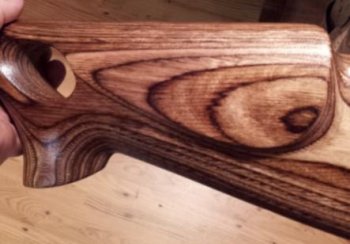Frank Hunter
Well-Known Member
Here's some first hand information on working with Dymondwood and similar laminates. This might apply to some makers but not all as it's not a high-value material but is very consistent and durable. Not to mention inexpensive for the color range available. A few things I've found -
Your handle pin holes will end up smaller than the drilled size. It's more noticeable in this material than other woods I've found for this so far, I don't know why the holes shrink so badly in this stuff but they do. A 1/4" bit leaves a hole that in no way will fit a 1/4" pin like the steel tang would. I use either a round rasp to slightly open it up or you can use a 9/32 bit on the scales. It also will occasionally shrink after installation and leave a slight amount of the tang proud of the finished surface, I've noticed this in the "Walnut" but not the "Silver/Black". Also, even though requiring no oil or polish aside from green or pink compound on a buffing wheel, it will burn yellow and brown if you get it too hot.
The dust is nasty and percolates a good 30 feet from the grinding area and will give you Technicolor boogers matching the current color you're working if you don't use a respirator, it seems to get around a dust mask to a greater extent than the natural materials. I haven't had my grinding bin catch fire but it will smoke and probably should be treated as much of a fire hazard as regular wood dust.
Any other points or specific thoughts about this stuff?
Your handle pin holes will end up smaller than the drilled size. It's more noticeable in this material than other woods I've found for this so far, I don't know why the holes shrink so badly in this stuff but they do. A 1/4" bit leaves a hole that in no way will fit a 1/4" pin like the steel tang would. I use either a round rasp to slightly open it up or you can use a 9/32 bit on the scales. It also will occasionally shrink after installation and leave a slight amount of the tang proud of the finished surface, I've noticed this in the "Walnut" but not the "Silver/Black". Also, even though requiring no oil or polish aside from green or pink compound on a buffing wheel, it will burn yellow and brown if you get it too hot.
The dust is nasty and percolates a good 30 feet from the grinding area and will give you Technicolor boogers matching the current color you're working if you don't use a respirator, it seems to get around a dust mask to a greater extent than the natural materials. I haven't had my grinding bin catch fire but it will smoke and probably should be treated as much of a fire hazard as regular wood dust.
Any other points or specific thoughts about this stuff?



